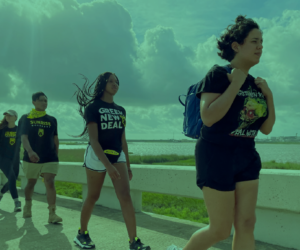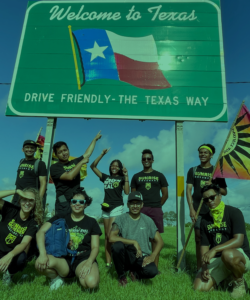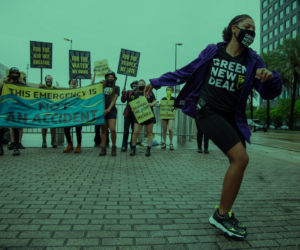From Issue 2
Becoming an Ocean Hero in 2019 changed the way that I think about activism forever, and helped me realize the power I have to create the change I want to see in the world. I have since led a 400 mile climate march across the Gulf South from my hometown of New Orleans, Louisiana to Houston, Texas. I have founded my own campaign: One Oysean, to center, uplift, and support young BIPOC activists in the environmental movement. I have organized protests at my local politician’s office and pressured him about his climate inaction. The thing is: If you told me a few years ago I would be doing these things today, I would have never believed you.
In my seventeen years of living, I have experienced firsthand climate destruction. At age two, my family and I fled my hometown of New Orleans, Louisiana, in fear of the destructive waters of Hurricane Katrina. We moved to Houston, Texas, where I was later affected by Hurricane Harvey and Winter Storm Uri, aka the “Texas Freeze,” in the winter of 2021. Every year the weather becomes more unpredictable, and natural disasters are in danger of being normalized. I felt the climate crisis knocking at my door and I knew I needed to take action now. Before I could ever dream of being the activist I am today, I needed a vision. A vision where youth could change the world.
I attended a “green” elementary school from second grade to fifth. Marshall Elementary was unique; it was completely innovative and the first of its kind in my district. It was here that I first learned compassion for the environment. Marshall was a large, two-story school with an eco-pond near its entrance, where tiny fish and red-ear slider turtles would breach the water’s surface, catching the eyes of students passing by. In the science garden we conducted soil tests and learned about how important bees were to the balance of the ecosystem. We learned about water conservation standing around a water trough, supplied by a large metal cistern. Inside the building, right before the central staircase, there was a tall yellow slide that students could use on special occasions such as birthdays or award ceremonies.

Our classrooms were spacious, accompanied by built-in treehouses down each hall that we used sometimes if our teacher wanted to change our scenery. The A/C unit was powered by a geothermal well field under our parking lot and playgrounds. The building was rimmed with large glass windows; natural light flooded our classrooms, and we rarely touched the manual switch for the electric lights. Outside there were three playgrounds made from recycled plastic. In the backfield, past the green monkey bars, stood a wind turbine that a group of fourth graders, learning about the different sources of renewable energy, inspected to later create their own wind turbine model.
Most of our lessons were environment-focused, and we followed a project-based curriculum. During one of my favorite projects, my class and I learned about the Zika virus and the relationship between birds and mosquitos. Texas had high rates of reported Zika cases at the time. I remember learning about the life cycle of mosquitoes, and how the Zika virus was transmitted to people through mosquito bites. We talked about how rainy Texas weather was on average and that mosquito eggs need water to hatch. Our teacher explained that to fight against the Zika virus, we needed to attract birds to eat the mosquitoes.
We worked in teams of four to build birdhouses, decorate them with bright paint and fill them with bird seeds to attract more birds to our playground. By the end of the year, the amount of students reporting mosquito bites compared to the beginning of our project decreased considerably. Our entire school and its sustainable elements were teaching tools that inspired us to care about our environment. Marshall showed me education could include real world environmental issues and that age was no restriction to creating solutions.

This passion later led me to join Ocean Heroes Bootcamp. During the summer of 2019, I found myself in a room with 300 other youth from all over the world. As we settled into the giant lecture hall at the University of British Columbia in Vancouver, I couldn’t help but wonder how I’d gotten this far. Little did I know, this experience, becoming an Ocean Hero, would change my life as an activist. Through the Ocean Heroes Network, I learned how to effectively implement the campaign skills and resources I needed to accomplish my goals. I learned about the different types of campaigns we could create. I saw first-hand the effects of plastic pollution while dissecting and sorting the microplastics lining the stomach of an albatross. I discussed social media strategies with Danni Washington and the Big Blue & You crew and later that day, practiced my elevator pitch with Sunny Angela, director of Plastic Paradise. I met so many kindred spirits in my fellow Ocean Heroes. I also met important adult allies from Captain Planet Foundation and from Lonely Whale, who made me feel uplifted as a young person. From the Netherlands to Hawaii to Vancouver to Texas, together, we imagined a world with clean seas and constructed tangible solutions to fight climate change.
With support from the Ocean Heroes Network, I built a platform to speak my truth when it came to environmental justice. As I told my climate story to large audiences, they began to look at the climate crisis as an urgent emergency. As a result, I created my One Oysean campaign to provide the same platform I’d been given to uplift and support other BIPOC who had similar stories to tell. Because of Ocean Heroes, I was able to organize a 400-mile climate march with the Sunrise Movement, even though I knew it would be far from easy. I walked through heavy rain, blistering heat, and everything in between for forty days.
Ocean Heroes Bootcamp changed the way I saw myself as an activist by opening up the bounds of my imagination. The powerful passionate energy I felt in that lecture hall back in 2019, I kept it with me. I used it to reimagine what the world could look like and stretch the bounds of what I thought was possible. I moved past being the person who attended beach clean-ups and started to organize them myself. I stopped wishing things would change and joined my friends around the globe to take climate action. That’s what makes my experience as an Ocean Hero so magical: standing with other youth from all over the world who are ready and willing to make a change in a world that tries to tell us we can’t, and knowing that we can.


